Haryana State Board HBSE 9th Class Maths Solutions Chapter 7 Triangles Ex 7.2 Textbook Exercise Questions and Answers.
Haryana Board 9th Class Maths Solutions Chapter 7 Triangles Exercise 7.2
Question 1.
In an isosceles triangle ABC with AB = AC, the bisectors of ∠B and ∠C intersect each other at O. Join A to O Show that:
(i) OB = OC
(ii) AO bisects ∠A.
Solution:
(i) In ΔABC, we have
AB = AC (Given)
⇒ ∠B = ∠C …….(i)
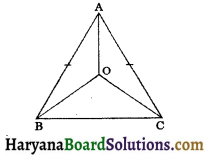
[∵ Angles opposite to equal sides are equal]
Since BO is the bisector of ∠B.
∴ ∠ABO = ∠CBO …(ii)
and CO is the bisector of ∠C.
∴ ∠ACO = ∠BCO …(iii)
From (i), (ii) and (iii), we get
∠ABO = ∠ACO …(iv)
and ∠CBO = ∠BCO
⇒ BO = CO …. (v)
(∵ Sides opposite to equal angles are equal)
(ii) In ΔABO and ΔACO, we have
AB = AC, (Given)
∠ABO = ∠ACO, [From (iv)]
and BO = CO [From (v)]
∴ ΔABO ≅ ΔACO,
(By SAS congruence rule)
⇒ ∠OAB = ∠OAC (CPCT)
OR AO bisects ⇒ A.
Hence Proved
![]()
Question 2.
In ΔABC, AD is the perpendicular bisector of BC (see figure 7.42). Show that ΔABC is an isosceles triangle in which AB = AC
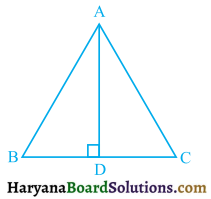
Solution:
In ΔADB and ΔADC,
we have BD = CD,
(∵ AD is the bisecor of BC)
∠ADB = ∠ADC,
(∵ AD ⊥ BC, ∴ Each = 90°)
and AD = AD, (Common)
∴ ΔADB ≅ ΔADC,
(By SAS congruence rule)
⇒ AB = AC, (CPCT)
Or ABC is an isosceles triangle.
Hence Proved
Question 3.
ABC is an isosceles triangle in which altitudes BE and CF are drawn to equal sides AC and AB respectively (see figure 7.43). Show that these altitudes are equal.
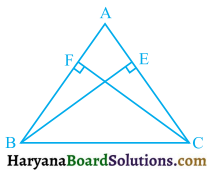
Solution:
In ΔABC, we have
AB = AC, (∵ ΔABC is an isosceles triangle)
⇒ ∠B = ∠C, (∵ Angles opposite to equal sides are equal)
Now, in ΔBFC and ΔCEB, we have
∠B = ∠C, (As proved above)
∠BFC = ∠CEB
(∵ CF ⊥ AB and BE ⊥ AC, ∴ Each = 90°)
and BC = BC, (Common)
∴ ΔBFC ≅ ΔCEB
(By AAS congruence rule)
⇒ CF = BE (CPCT)
Hence proved
![]()
Question 4.
ABC is a triangle in which altitudes BE and CF to sides AC and AB are equal (see figure 7.44). Show that:
(i) ΔABE ≅ ΔACF
(ii) AB = AC, i.e., ABC is an isosceles triangle.
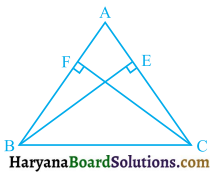
Solution:
(i) In ΔABE and ΔACF, we have
∠AEB = ∠AFC
[∵ BE ⊥ AC and CF ⊥ AB
∴ Each = 90°]
∠BAE = ∠CAF (Common)
and BE = CF, (Given)
ΔABE ≅ ΔACF,
(By AAS congruence rule)
(ii) ΔABE ≅ ΔACF
(As proved above)
⇒ AB = AC, (CPCT)
Or ABC is an isosceles triangle.
Hence proved
Question 5.
ABC and DBC are two isosceles triangles on the same base BC (see figure 7.45). Show that ∠ABD = ∠ACD.
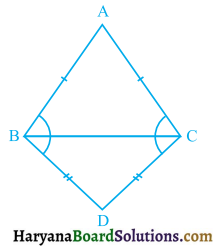
Solution:
In ΔABC, we have
AB = AC (∵ ΔABC is an isosceles triangle)
⇒ ∠ABC = ∠ACB ……..(i)
(∵ Angles opposite to equal sides are equal) Again in ΔDBC, we have
DB = DC (∵ ΔDBC is an isosceles triangle)
⇒ ∠DBC = ∠DCB, ……..(ii)
(∵ Angles opposite to equal sides are equal)
Adding (i) and (ii), we get
∠ABC + ∠DBC = ∠ACB +∠DCB
⇒ ∠ABD = ∠ACD. Hence proved.
![]()
Question 6.
ΔABC is an isosceles triangle in which AB = AC. Side BA is produced to such that AD = AB (see figure 7.46). Show that ∠BCD is a right angle.
[NCERT Exemplar Problems]
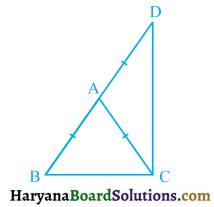
Solution:
Given: ΔABC in which AB = AC. Side BA is produced to D such that
AD = AB
To prove : ∠BCD = 90°.
Construction: Join C to D.
Proof: In ΔABC, we have
AB = AC (Given)
⇒ ∠ABC = ∠ACB …….(i)
(∵ Angles opposite to equal sides are equal)
AB = AD, (Given)
∴ AD = AC (∵ AB = AC)
⇒ ∠ADC = ∠ACD …(ii) (∵ Angles opposite to equal sides are equal)
Adding (i), (ii), we get
∠ABC + ∠ADC = ∠ACB + ∠ACD
∠ABC + ∠ADC = ∠BCD
∠DBC + ∠BDC = ∠BCD (from fig. ∠ABC = ∠DBC and ∠ADC = ∠BDC)
Now in ΔBCD, we have
∠DBC + ∠BDC + ∠BCD = 180°,
(∵ Sum of interior angles of a triangle = 180°)
⇒ ∠BCD + ∠BCD = 180°, [Using (iii)]
⇒ 2∠BCD = 180°
⇒ ∠BCD = \(\frac {180°}{2}\) = 90°
Or ∠BCD is a right angle. Hence Proved
Question 7.
ABC is a right-angled triangle in which ∠A = 90° and AB = AC. Find ∠B and ∠C.
Solution :
In ΔABC, we have
∠A = 90° and
AB = AC
⇒ ∠B = ∠C …(i) (∵ Angles opposite to equal sides are equal)

Now in ΔABC, we have
∠A + ∠B + ∠C = 180°, (∵ Sum of interior angles of a triangle = 180°)
⇒ 90° + ∠B + ∠B = 180°,
[∵ From (i), ∠C = ∠B]
⇒ 2∠B = 180° – 90°,
⇒ 2∠B = 90°
⇒ ∠B = \(\frac {90°}{2}\) = 45°
Hence, ∠B = ∠C = 45°
![]()
Question 8.
Show that the angles of an equilateral triangle are 60° each. [NCERT Exemplar Problems]
Solution :
Let ΔABC be an equilateral triangle.
So, AB = BC = AC
Now, AB = AC
⇒ ∠B = ∠C ……..(i)
(Angles opposite to equal sides are equal)
Again, BC = AC
⇒ ∠B = ∠A ……..(ii)
[Angles opposite to equal sides are equal]
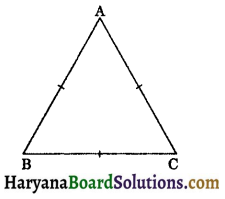
From (i) and (ii), we get
∠A = ∠B = ∠C …(iii)
Now ∠A + ∠B + ∠C = 180°
[∵ Sum of interior angles of a Δ = 180°]
⇒ ∠A + ∠A + ∠A = 180° [Using (iii)]
⇒ 3∠A = 180°
⇒ ∠A = \(\frac {180°}{3}\) = 60°
∴ ∠A = ∠B = ∠C = 60°
Hence, each angle of an equilateral triangle is 60°
Hence Proved